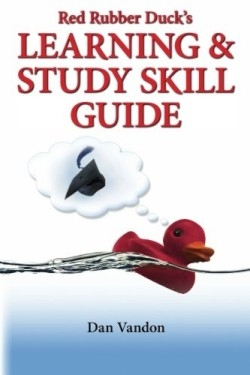Red Rubber Duck's Learning & Study Skill Guide
Bob is using a bucket to empty a river into a bottle, and as one might guess, it isn’t going very well. The bucket is too small for the river, and too large for the neck of the bottle. Dan Vandon uses the story of “the Bottle, the Bucket, and Bob”—one of many analogies in this guide—to put forth his thesis about studying and learning. The river is course information, the bucket is working memory, and the bottle is long-term memory. The student’s task is to “pass the test”: to fill up the bottle with enough pertinent course material to succeed on exams and in life. To this end, Vandon urges students to use the most appropriate tools and the best strategy for efficient processing of information.
Surprisingly, Vandon’s approach to achieving more with less work offers no shortcuts or quick fixes. He stresses the importance of personal responsibility and commitment, and he urges students to fine-tune their own personal learning techniques. He allows that exams are often artificial and arbitrary, but he reminds that exam scores open and close the door to opportunity. Having earned law degrees in several countries, Vandon is no stranger to information overload and the pressure to always pass more exams. This guide, while drawing on theoretical models for learning, is written in everyday language with no citations. Vandon uses analogies and examples as well as visuals—tables, charts, and graphic representations—to explain his ideas. His book offers a way to study and learn and, in the end, pass the test. His intended audience is college students or anyone with a need to retain large amounts of verbal information.
The essentials of Vandon’s “basic algebra of studying and learning” are the Association Tool, the Big Picture Tool, and the Structure Tool. The first is a method of assigning physical “triggers” to help the learner remember list items, abstract ideas, and concrete numbers. Like a visitor to a new city, a student also needs the equivalent of a map and guidebook in order to have a glimpse of the whole—the Big Picture—rather than meaningless parts. And in the same way that learners need a list of ingredients and steps for the process of baking a cake, the Structure Tool helps to uncover the organization of detail in a text—the steps, hierarchies, sequences, timelines, and other patterns of organization. Vandon caps these tools with a “going for day x” exam strategy that includes defining goals, estimating the course content and the skills needed to master it, and writing a working plan, or “roadmap to success.”
Always, Vandon pushes an active approach to learning, and his book is a model of active teaching that involves the body and the senses so as to help Bob, the student, maximize the storage of river water in the bucket and the bottle.
Reviewed by
Joe Taylor
Disclosure: This article is not an endorsement, but a review. The publisher of this book provided free copies of the book and paid a small fee to have their book reviewed by a professional reviewer. Foreword Reviews and Clarion Reviews make no guarantee that the publisher will receive a positive review. Foreword Magazine, Inc. is disclosing this in accordance with the Federal Trade Commission’s 16 CFR, Part 255.

